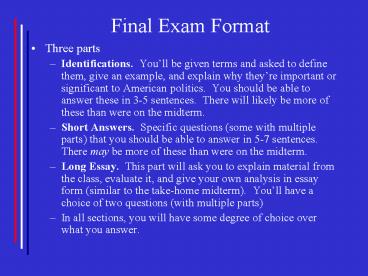Final Exam Format - PowerPoint PPT Presentation
1 / 24
Title: Final Exam Format
1
Final Exam Format
- Three parts
- Identifications. Youll be given terms and asked
to define them, give an example, and explain why
theyre important or significant to American
politics. You should be able to answer these in
3-5 sentences. There will likely be more of
these than were on the midterm. - Short Answers. Specific questions (some with
multiple parts) that you should be able to answer
in 5-7 sentences. There may be more of these
than were on the midterm. - Long Essay. This part will ask you to explain
material from the class, evaluate it, and give
your own analysis in essay form (similar to the
take-home midterm). Youll have a choice of two
questions (with multiple parts) - In all sections, you will have some degree of
choice over what you answer.
2
Chapter One Key Concepts
- Logic of collective action
- Free rider problem
- Article 1-1 in Reader Olson from The Logic of
Collective Action. Be prepared to talk about his
arguments in relation to interest groups. - The prisoners dilemma
3
Chapter One Key Concepts
- Delegation
- Principal-agent relationship
- Shirking
- Agency loss
- Be prepared to apply these, especially in the
context of the relationships between the people
and the government and each branch of government
and the bureaucracy.
4
Chapter One Key Concepts
- Transaction costs
- Conformity costs
5
Chapter 6 Congress
- How electoral logic creates a prisoners dilemma
when it comes to passing laws (review Logic pp.
219-220). Responsiveness versus responsibility.
6
Chapter 7 The Presidency
- Why was the 19th century presidency referred to
as that of chief clerk? How did the typical
president of that era spend his day? - Central clearance
- Executive orders
- The veto game.
7
Chapter 7 The President
- Why is bargaining important? (see article 7-1 by
Neustadt) - What is going public and why do presidents use
it? (see also article 7-2 by Kernell) - How does the news media complicate the ability to
go public? (Ch 14 material may also be useful) - How does whether the government is unified or
divided affect the choice between bargaining and
going public?
8
Chapter 8 The Bureaucracy
- Who controls the bureaucracy? (See pp. 297-317)
- Congress
- The president
- The courts
- The bureaucracy
- Interest groups
- What methods of control are available to each?
- How might bureaucrats have an advantage in the
relationship? - Apply principal-agent framework.
9
Chapter 8 The Bureaucracy
- Define iron triangle
- What is red tape and why does it exist? Why is
it important? - The spoils system and civil service reform (See
Ch 7 as well) What were the advantages and
disadvantages of the spoils system? What are the
advantages and disadvantages of civil service
reform?
10
11/14 Lecture
- Ex parte McCardle and appellate jurisdiction
- Roosevelts court packing plan. What was it?
Why did he propose it? Did he get what he
wanted? - What happens if the Court rules a law of Congress
unconstitutional and Congress doesnt like it? - Immigration and Naturalization Service v. Chadha
(1983)
11
Chapter 10 Public Opinion
- Scientific polling versus straw polls
- Framing
- Political socialization
12
Chapter 10 Public Opinion
- Is public opinion meaningful?
- Do citizens know what they need to know? (later
chapters as well) - Opinion leaders
- Cognitive shortcuts (Chapter 11 as well).
13
Chapter 11 Voting, Campaigns, and Elections
- Logic of elections (keeping agents in check)
- What needs to happen for this to be an effective
check on power?
14
Chapter 11 Voting, Campaigns, and Elections
- Suffrage how and why did it expand over time?
- What makes people more or less likely to vote?
What effect might this have on democracy?
15
Chapter 11 Voting, Campaigns, and Elections
- How do voters decide? What do they base their
decision on? What kind of cognitive shortcuts do
they employ? (See also 11-1 in Principles and
Practice) - message
16
Chapter 12 Political Parties
- Why do we have political parties? What functions
do they perform? (covered in class 11/21)
17
Chapter 12 Political Parties
- What are party machines?
- What is the Australian ballot?
- How did it, along with other progressive reforms,
undermine party machines? - What were the unintended consequences of these
progressive reforms? - (see Logic pp. 478-483 )
18
Chapter 13 Interest Groups
- Pluralism/Trumans theory and its critics (Logic,
lectures, Olson in 1-1 and Schattschneider in
13-1). What evidence supports each
theory/argument? What doesnt?
19
Chapter 13 Interest Groups
- How do interest groups try and overcome the free
rider problem?
20
Chapter 13 Interest Groups
- Insider versus outsider tactics. What are they?
Why use each? - What are some of the limits on the power of PACs?
What can they gain through their campaign
contributions? (see also chapter 11)
21
Chapter 14 The News Media
- Why were newspapers linked to political parties
early on and what enabled them to later establish
independence?
22
Chapter 14 The News Media
- The relationship between reporters and
politicians and their varying goals
23
Chapter 14 The News Media
- What is a trial balloon?
- What is a leak? What different kinds are there?
Why do people use them? - Beats
24
- Finals week office hours 1030-100 Monday and
Wednesday at the Grove (in the unlikely event of
rain, come to SSB 325 instead) - E-mail llrice_at_ucsd.edu
- Final Exam Thursday, December 8 1130































